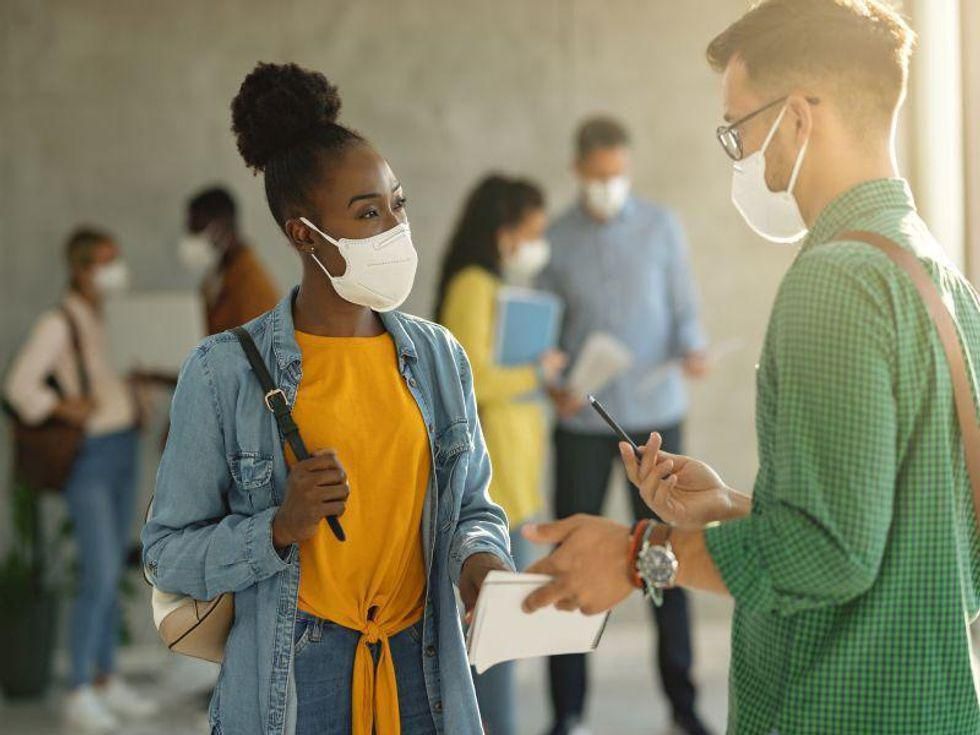TUESDAY, July 27, 2021 (HealthDay News) — Unlike prior strains, the Delta variant is triggering higher viral loads in rare cases of “breakthrough” infections in people fully vaccinated against COVID-19, making transmission more likely and causing the U.S. Centers for Disease Control and Prevention to call for everyone to wear masks indoors in some contexts.
The latest decision is a sharp reversal from one the agency announced just two months ago, when it said that vaccinated people could shed their masks while inside.
But reports of more highly transmissible cases among vaccinated people — most of whom will have mild or no symptoms — as well as surging caseloads among the unvaccinated in regions with low vaccination rates, prompted the latest decision, CDC director Dr. Rochelle Walensky acknowledged during a Tuesday media briefing.
“The Delta variant behaves uniquely differently from past strains of the virus that causes COVID-19,” Walensky noted. “Information on the Delta variant from several states and other countries indicates that in rare occasions, some vaccinated people infected with the Delta variant after vaccination may be contagious and spread the virus to others.”
“Unlike the Alpha variant we had back in May, where we didn’t believe that if you were vaccinated you could transmit further, this is different now with the Delta variant,” she explained. “We’re seeing now that it’s actually possible if you’re a rare breakthrough infection that you can transmit further…”
“This new science is worrisome and unfortunately warrants an update to our recommendations,” Walensky said.
However, she added, “we continue to estimate that the risk of a breakthrough infection with symptoms upon exposure to the Delta variant is reduced by sevenfold [among the vaccinated]. The reduction is twentyfold for hospitalizations and deaths.”
She added that “of the transmission that is happening in the country right now, the vast majority of transmission occurring is occurring through unvaccinated individuals.”
Guidance varies with region
The CDC’s renewed guidance on mask-wearing indoors isn’t for the country as a whole, but rather for areas with substantial or high levels of transmission — essentially 50 or more cases per 100,000 over a seven-day period, Walensky said.
CDC officials also recommended universal masking for teachers, staff, students and visitors in schools, but they added that, with additional precautions, schools should still return to in-person learning in the fall.
“The vaccines continue to do an exceptional job in protecting the individual who is vaccinated from severe illness, hospitalization and death, and even against mild illness,” Walensky stressed during the briefing. “In those rare cases that we have breakthrough infections, we felt it important for people to understand they have the potential to transmit virus to others.”
Reaction to the new guidance was mixed.
“I think that’s great,” Dr. Celine Gounder, an infectious disease specialist at Bellevue Hospital Center in New York City, toldThe New York Times. Based on what scientists are learning about the Delta variant’s ability to cause breakthrough infections, she said, “this is a move in the right direction.”
But Dr. Amesh Adalja, an infectious disease expert and senior scholar at Johns Hopkins Center for Health Security in Baltimore, strongly disagreed that a return to masks is the right decision.
“I have not seen data that shows that vaccinated individuals are driving this pandemic. The CDC director and the president have said this is a pandemic of the unvaccinated, but yet the vaccinated are being asked to wear masks — both can’t be true,” he said.
“And to what end are we wearing masks for? COVID is not a disease that can be eradicated or limited, and we will always have cases,” Adalja added. “The goal was to make it a manageable respiratory illness, and it is so in many places where enough high-risk individuals have been vaccinated.”
“If you are immuno-suppressed, there may be a benefit to wearing a mask post-vaccination. But, for the general healthy public that’s fully vaccinated, I don’t really see this as being anything more than [of] marginal value,” he noted. “Lastly, the places where you want people to wear masks or where vaccination rates are low are comprised of those individuals [who] are unlikely to wear a mask. The solution is the vaccine, not masks.”
Changing data, changing advice
As of Tuesday, 57.5% of all Americans aged 12 and older were fully vaccinated, according to the CDC.
In May, the CDC guidance did still recommend that unvaccinated people wear masks. Those recommendations drew sharp criticism from some experts, who said it was premature because so many Americans are still not fully vaccinated.
At the time, Walensky pointed to two scientific findings as significant factors in the May guidance. Few vaccinated people become infected with the virus, and transmission seemed rarer still, she noted, while the vaccines appear to be effective against all known variants of the coronavirus, the Times said.
A day after the May announcement, the agency released results from a large study showing that the mRNA vaccines made by Pfizer and Moderna were 94% effective in preventing symptomatic illness in those who got two doses, and 82% effective in those who had received one dose, the Times reported.
But those data were based on infections that occurred before the Delta variant began sweeping through the country.
More information
Visit the U.S. Centers for Disease Control and Prevention for more on masking properly during the pandemic.
SOURCES: Amesh Adalja, MD, Johns Hopkins Center for Health Security, Baltimore; The New York Times
Copyright © 2025 HealthDay. All rights reserved.

